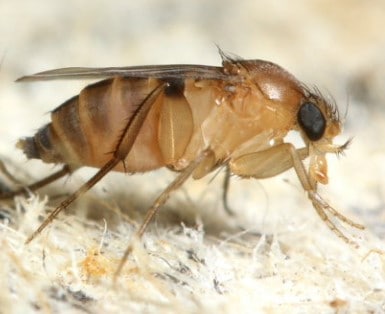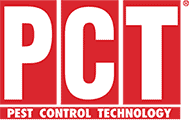
Phorid flies are a type of nuisance house infesting fly that feed on decaying organic materials. Along with causing problems for homeowners they can also become problematic in commercial kitchens, hospitals and mortuaries.
| Pest Identification | |
|---|---|
| Recognition | Phorid flies are commonly called “humpbacked” flies and this is because of their arched thorax which gives them a humpbacked appearance. Adults grow to between 1/16th and 1/8th of an inch in length are dark brown to black in color, and the largest segment of their hind legs is laterally flattened. Phorid flies have a short flight pattern that is jerky and non-linear. |
| Biology | Phorid flies have a short life-cycle that under the right conditions will be completed in approximately 3 weeks. Each female will lay a few hundred eggs on or near a food source over a period of time. The larvae will hatch and they will feed on the moist decaying materials that they are in or near; after fully developing the larvae will move to a drier location and pupate. After pupating adults will emerge to mate and lay the next generation of phorid flies. |
| Habits | Phorid flies lay their eggs and feed on decaying food, rotting plants, manure, and decaying animal carcasses. They are particularly fond of the decaying materials that are found built up in the drains of sinks and bathtubs but they can also become problematic in homes and other buildings if there is a water leak under the foundation or behind a wall. These flies will flourish in those moist areas and enter into your house through any small cracks and crevices that they find. Phorid flies are found living and feeding on decaying materials and feces which means that when they enter into your home they can contaminate food sources and food prep areas with serious diseases. Because these flies are so unsanitary, they can cause serious issues in hospitals (invading wounds) and restaurant facilities. |
| Prevention | As a homeowner, there are several things that you can do to help lessen the chances of phorid flies becoming a problem in your house. Reduce the places around your home that phorid flies may breed by repairing any leaky pipes or fixtures in your home; make sure that gutters are directing water away from your house and make sure that drains are regularly cleared of debris. Seal any cracks or crevices in your home’s foundation and caulk any gaps around windows doors. It is also important that if you have pets to clean up their feces on a regular basis. Inside of your home store food in the refrigerator or in sealed containers instead of out on the open on counters or tables. |
| Professional | The most effective way to control phorid flies is with the help of a professional pest control expert. At Rotter Lawn & Pest Solutions, a trained technician will inspect your home and find the areas and items that could be attracting phorid flies to it and they will also find their breeding sites. We will then provide control services through our year-round home pest control services and provide suggestions for how to control and prevent future problems with phorid flies within your home and business. |

